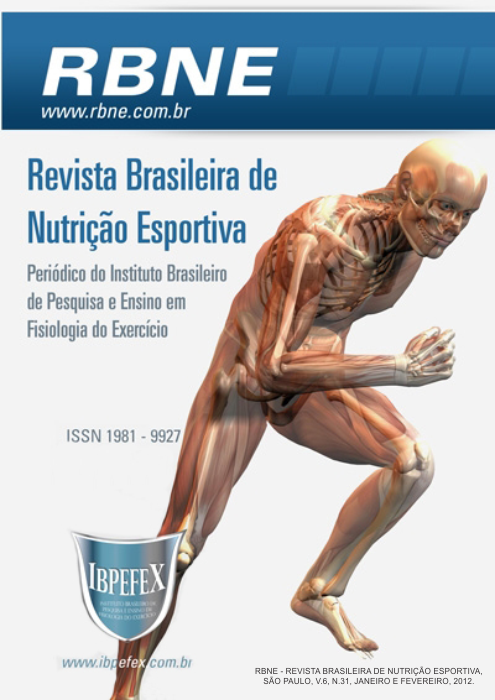Percentage of fat in practitioners of Jiu-Jitsu in the city of academies Florianópolis-SC
Abstract
The objective of this study was to investigate fourteen professional athletes jiu-jitsu in different categories, competing at state, nationaland international, of different ages and goals for the estimation of percent body fat (% BF), using the equation Oppliger and Tipton (1984). This study was characterized as a cross-sectional observational study. The average fat percentage of the sample was 11.4±3.6. Analyzing the results for the parameters proposed by Heyward & Stolarczyk (1996) it was observed in a fighter's super-heavyweight category the highest value calculated for the percentage of fat (14.9%), ranked as average. For the lowest calculated value, a lightweight fighter, the percent fat of 5.3%, classified as hazardous. Analyzing the results of the fat percentage of Jiu-jitsu, there was a linear increase according to weight categories of heavier athletes tend to have a higher percentage offat, this is confirmed by male wrestlers that point to a low fat percentage (less than 10%) except for the heavier categories as heavyweight to (84.99 kg), heavy (up to 90.99 kg), super-heavyweight (up to 96.99 kg) and very heavy (over 97 kg). Based on these results, studies are needed with larger samples and more precise methods to enable a statistical evaluation andaconclusion more refined.
References
-Aahperd. American alliance for health, phisical education, recreation and dance. Tecnical Manual: Related Phisical Fitness. Virgínia: [s.n], 1984.
-AmericanCollegeSportsMedicine. Position Stand on Weight Loss in Wrestlers. Med Sci Sports Exerc, Vol.28, Núm.2, p.135-138, 1996.
-Behnke, A. R.; Wilmore, J. H. Evaluation and regulation of body build and composition. Englewood Cliffs (NJ): Prentice Hall, 1974.
-Beneetti, T. R. B.; Pinho, R. A.; Ramos, V.M. Dobras cutâneas. In: Petroski, E. L. (Org.). Antropometria: técnicas e padronizações. Porto Alegre: Pallotti, 1999.
-Brito, C.J.; e colaboradores. Methods of Body Mass Reduction by Combat Sports' Athletes. International Journal of Sport Nutrition and Exercise Metabolism. Vol. 22, Núm. 2, p. 89-97, 2012.
-Callister, R.;e colaboradores. Physiological characteristics of elite judo athletes. International Journal of Sports Medicine, Vol. 12, p. 196-203, 1991.
-Carpi, M. J.; e colaboradores. Association between two different types of strangling and intraocular pressure variation in jiu-jitsu athletes. Arquivos Brasileiros de Oftalmologia, Vol. 72, Núm. 3, p. 341-345, 2009.
-Carvalho, M. C. G. A.; e colaboradores. Campeonato Paulista Sênior de Judô de 1999: uma descrição cineantropométrica de seus participantes. In: LADESP/ Departamento de Esporte/EEFE/USP. Grupo de estudos de Judô. 2000. Disponível em: <http://www.judobrasil.com.br>. Acesso em: 10/02/2012.
-Choma, C.W.; Sforzo, G.A; Keller, B.A. Impact of rapid weight loss on cognitive function in collegiate wrestlers. Medicine and Science in Sport and Exercise, Vol. 30, Núm. 4, p. 746-749, 1998.
-Clark, R. R.; Kuta, J. M.; Sullivan, J. C. Cross validation of methods to predict body fat in african-american and caucasian collegiate fooball player. Research Ouarterly for Sport, Vol. 65, Núm. 19, p. 21-30, 1994.
-CBJJ. Confederação Brasileira de Jiu-Jitsu. Disponível em: < http://www.cbjj. com.br/home.htm >. Acesso em: 10/02/2012.
-Fox, E.; Bowers, R. W.; Foss, M. L. Bases fisiológicas da educação física e dos desportos. 4ªedição. Rio de Janeiro: Guanabara Koogan, 1991.
-Grosso, F.; e colaboradores. Perfil somatotípico e composição corporal de atletas de judô brasileiros masculinos cegos e deficientes visuais. EFDeportes.com, Revista Digital. Buenos Aires. Ano 11, Núm.106, 2007.
-Heyward, V. H.; Stolarczyk, L. M. Applied body composition assessment. Champaign: Human Kinetics Publishers, 1996.
-Kõnig, M. F.; Batra, S. Relationship between body fat and anthropometric variables in a large sample of young males. Intemational Joumal of Sports and Medicine, Vol. 15, Núm. 4, p. 163-164, 1994.
-Kraemer, W. J.; e colaboradores. Influence of exercise training on physiological and performance changes with weight loss in mem. Medicine and Science in Sports and Exercise, Vol. 31, Núm. 9, p. 1320-1329, 1999.
-Lohman, T.G. Advances in body composition assessment. Champaign: Human Kinetics Publishers, 1992.
-Lopes, A. S.; Neto, C. S. P. Equações preditivas da gordura corporal em crianças com diferentes características Étnico-Culturais no Estado de Santa Catarina, Brasil. Tese Doutorado. Universidade Federal de Santa Maria. Santa Maria.1997.
-Mancini, A.M.; Machado, H.S.; Keller, B.; Santos, S.L.C. Associação entre perfil antropométrico e o desempenho de atletas de luta olímpica. EFDeportes.com, Revista Digital. Buenos Aires. Ano 13. Núm. 123. 2008.
-Materko, W.; e colaboradores. Prediction model of a maximal repetition (1RM) based on male and female anthropometrical characteristics. Rev Bras Med Esporte. Vol. 13, Núm. 1, p.27-32, 2007.
-Pires, R.; e colaboradores. Perfil antropométrico e de composição corporal de lutadores de combate. Importância do diagnóstico correto. EFDeportes.com, Revista Digital. Buenos Aires. Ano16, Núm.156, 2011.
-PBDEERGF (Plano Básico de Desenvolvimento Ecológico-Econômico para a Região da Grande Florianópolis). Disponível em: http://soo.sdr.sc.gov.br/index.php?option=com_docman&task=doc, acessado em 10/02/2012.
-Rossi, L. Abel, T. Souza, L. Perfil antropométrico e nutricional de atletas de kung fu. Revista Mackenzie de Educação Física e Esporte, Vol. 9, Núm. 2, p.83-89, 2010.
-Tipton, C.M.; Opploger, R.A. The Iowa Wrestling Study: lessons for physicians. Iowa Medicine, Vol. 74, p.381-385, 1984.
Authors who publish in this journal agree to the following terms:
- Authors retain the copyright and grant the journal the right of first publication, with work simultaneously licensed under the Creative Commons Attribution License BY-NC which allows the sharing of the work with acknowledgment of the authorship of the work and initial publication in this journal.
- Authors are authorized to enter into additional contracts separately for non-exclusive distribution of the version of the work published in this journal (eg, publishing in institutional repository or book chapter), with acknowledgment of authorship and initial publication in this journal.
- Authors are allowed and encouraged to post and distribute their work online (eg, in institutional repositories or on their personal page) at any point before or during the editorial process, as this can bring about productive change as well as increase impact and impact. citation of published work (See The Effect of Free Access).






